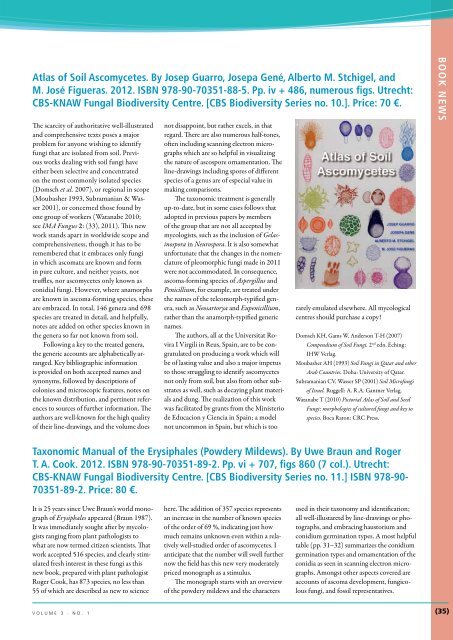BOOK NEWS Smut Fungi of the World. By Kálmán ... - IMA Fungus
BOOK NEWS Smut Fungi of the World. By Kálmán ... - IMA Fungus
BOOK NEWS Smut Fungi of the World. By Kálmán ... - IMA Fungus
Create successful ePaper yourself
Turn your PDF publications into a flip-book with our unique Google optimized e-Paper software.
Atlas <strong>of</strong> Soil Ascomycetes. <strong>By</strong> Josep Guarro, Josepa Gené, Alberto M. Stchigel, and<br />
M. José Figueras. 2012. ISBN 978-90-70351-88-5. Pp. iv + 486, numerous figs. Utrecht:<br />
CBS-KNAW Fungal Biodiversity Centre. [CBS Biodiversity Series no. 10.]. Price: 70 €.<br />
The scarcity <strong>of</strong> authoritative well-illustrated<br />
and comprehensive texts poses a major<br />
problem for anyone wishing to identify<br />
fungi that are isolated from soil. Previous<br />
works dealing with soil fungi have<br />
ei<strong>the</strong>r been selective and concentrated<br />
on <strong>the</strong> most commonly isolated species<br />
(Domsch et al. 2007), or regional in scope<br />
(Moubasher 1993, Subramanian & Wasser<br />
2001), or concerned those found by<br />
one group <strong>of</strong> workers (Watanabe 2010;<br />
see <strong>IMA</strong> <strong>Fungus</strong> 2: (33), 2011). This new<br />
work stands apart in worldwide scope and<br />
comprehensiveness, though it has to be<br />
remembered that it embraces only fungi<br />
in which ascomata are known and form<br />
in pure culture, and nei<strong>the</strong>r yeasts, nor<br />
truffles, nor ascomycetes only known as<br />
conidial fungi. However, where anamorphs<br />
are known in ascoma-forming species, <strong>the</strong>se<br />
are embraced. In total, 146 genera and 698<br />
species are treated in detail, and helpfully,<br />
notes are added on o<strong>the</strong>r species known in<br />
<strong>the</strong> genera so far not known from soil.<br />
Following a key to <strong>the</strong> treated genera,<br />
<strong>the</strong> generic accounts are alphabetically arranged.<br />
Key bibliographic information<br />
is provided on both accepted names and<br />
synonyms, followed by descriptions <strong>of</strong><br />
colonies and microscopic features, notes on<br />
<strong>the</strong> known distribution, and pertinent references<br />
to sources <strong>of</strong> fur<strong>the</strong>r information. The<br />
authors are well-known for <strong>the</strong> high quality<br />
<strong>of</strong> <strong>the</strong>ir line-drawings, and <strong>the</strong> volume does<br />
not disappoint, but ra<strong>the</strong>r excels, in that<br />
regard. There are also numerous half-tones,<br />
<strong>of</strong>ten including scanning electron micrographs<br />
which are so helpful in visualizing<br />
<strong>the</strong> nature <strong>of</strong> ascospore ornamentation. The<br />
line-drawings including spores <strong>of</strong> different<br />
species <strong>of</strong> a genus are <strong>of</strong> especial value in<br />
making comparisons.<br />
The taxonomic treatment is generally<br />
up-to-date, but in some cases follows that<br />
adopted in previous papers by members<br />
<strong>of</strong> <strong>the</strong> group that are not all accepted by<br />
mycologists, such as <strong>the</strong> inclusion <strong>of</strong> Gelasinospora<br />
in Neurospora. It is also somewhat<br />
unfortunate that <strong>the</strong> changes in <strong>the</strong> nomenclature<br />
<strong>of</strong> pleomorphic fungi made in 2011<br />
were not accommodated. In consequence,<br />
ascoma-forming species <strong>of</strong> Aspergillus and<br />
Penicillium, for example, are treated under<br />
<strong>the</strong> names <strong>of</strong> <strong>the</strong> teleomorph-typified genera,<br />
such as Neosartorya and Eupenicillium,<br />
ra<strong>the</strong>r than <strong>the</strong> anamorph-typified generic<br />
names.<br />
The authors, all at <strong>the</strong> Universitat Rovira<br />
I Virgili in Reus, Spain, are to be congratulated<br />
on producing a work which will<br />
be <strong>of</strong> lasting value and also a major impetus<br />
to those struggling to identify ascomycetes<br />
not only from soil, but also from o<strong>the</strong>r substrates<br />
as well, such as decaying plant materials<br />
and dung. The realization <strong>of</strong> this work<br />
was facilitated by grants from <strong>the</strong> Ministerio<br />
de Educacion y Ciencia in Spain; a model<br />
not uncommon in Spain, but which is too<br />
rarely emulated elsewhere. All mycological<br />
centres should purchase a copy!<br />
Domsch KH, Gams W, Anderson T-H (2007)<br />
Compendium <strong>of</strong> Soil <strong>Fungi</strong>. 2 nd edn. Eching:<br />
IHW Verlag.<br />
Moubasher AH (1993) Soil <strong>Fungi</strong> in Qatar and o<strong>the</strong>r<br />
Arab Countries. Doha: University <strong>of</strong> Qatar.<br />
Subramanian CV, Wasser SP (2001) Soil Micr<strong>of</strong>ungi<br />
<strong>of</strong> Israel. Ruggell: A. R.A. Gantner Verlag.<br />
Watanabe T (2010) Pictorial Atlas <strong>of</strong> Soil and Seed<br />
<strong>Fungi</strong>: morphologies <strong>of</strong> cultured fungi and key to<br />
species. Boca Raton: CRC Press.<br />
<strong>BOOK</strong> <strong>NEWS</strong><br />
Taxonomic Manual <strong>of</strong> <strong>the</strong> Erysiphales (Powdery Mildews). <strong>By</strong> Uwe Braun and Roger<br />
T. A. Cook. 2012. ISBN 978-90-70351-89-2. Pp. vi + 707, figs 860 (7 col.). Utrecht:<br />
CBS-KNAW Fungal Biodiversity Centre. [CBS Biodiversity Series no. 11.] ISBN 978-90-<br />
70351-89-2. Price: 80 €.<br />
It is 25 years since Uwe Braun’s world monograph<br />
<strong>of</strong> Erysiphales appeared (Braun 1987).<br />
It was immediately sought after by mycologists<br />
ranging from plant pathologists to<br />
what are now termed citizen scientists. That<br />
work accepted 516 species, and clearly stimulated<br />
fresh interest in <strong>the</strong>se fungi as this<br />
new book, prepared with plant pathologist<br />
Roger Cook, has 873 species, no less than<br />
55 <strong>of</strong> which are described as new to science<br />
here. The addition <strong>of</strong> 357 species represents<br />
an increase in <strong>the</strong> number <strong>of</strong> known species<br />
<strong>of</strong> <strong>the</strong> order <strong>of</strong> 69 %, indicating just how<br />
much remains unknown even within a relatively<br />
well-studied order <strong>of</strong> ascomycetes. I<br />
anticipate that <strong>the</strong> number will swell fur<strong>the</strong>r<br />
now <strong>the</strong> field has this new very moderately<br />
priced monograph as a stimulus.<br />
The monograph starts with an overview<br />
<strong>of</strong> <strong>the</strong> powdery mildews and <strong>the</strong> characters<br />
used in <strong>the</strong>ir taxonomy and identification;<br />
all well-illustaretd by line-drawings or photographs,<br />
and embracing haustorium and<br />
conidium germination types. A most helpful<br />
table (pp. 31–32) summarizes <strong>the</strong> conidium<br />
germination types and ornamentation <strong>of</strong> <strong>the</strong><br />
conidia as seen in scanning electron micrographs.<br />
Amongst o<strong>the</strong>r aspects covered are<br />
accounts <strong>of</strong> ascoma development, fungicolous<br />
fungi, and fossil representatives.<br />
volume 3 · no. 1<br />
(35)
















